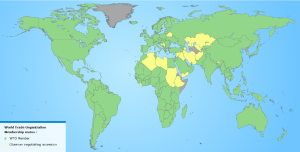Historic Global Trade Agreement Reached at WTO Summit

| Indonesian Trade Minister Gita Wiryawan, right, shakes hands with World Trade Organization (WTO) Director-General Roberto Azevedo, left, during the closing ceremony of the ninth WTO Ministerial Conference in Bali, Indonesia, Saturday, Dec. 7, 2013. (AP Photo/Firdia Lisnawati) |
07 December, 2013
Long criticized for its inability to forge meaningful agreements on multi-lateral trade terms, the World Trade Organization (WTO) has finally made its mark on history in the latest world summit held in Bali this week. This is the first serious agreement that the 159 member nations of the WTO have been able to consummate in nearly 20 years.
As WTO Director-General Roberto Azevedo summarized in his post-summit comments: “‘We have put the world back into the World Trade Organization. For the first time in our history, the WTO has truly delivered.’’ Trade ministers had come to the four-day WTO meeting with little hope that an agreement would be reached after years of inertia in trade negotiations.
Initial commentary on the deal speculates that it could boost global trade by $1 trillion over time and also keeps alive the WTO’s broader Doha Round of trade negotiations, sometimes known as the development round because of sweeping changes in regulations, taxes and subsidies that would benefit low income countries. Azevedo said the WTO will spend the next year developing a fresh approach for moving forward with the Doha negotiations.
To assist in appreciatingthe potential scope of this agreement, below is a map that overviews the global presence of the 159 nation membership in the WTO at present:
The National Association of Manufacturers in the U.S. (NAM) commented that terms of the agreement providing for more predictable, efficient and transparent customs procedures among WTO member nations is an outcome that will help manufacturers in the United States access 95 percent of global customers that live outside our borders more effectively and efficiently.
NAM lauded provisions of the agreement which increase transparency and accountability in global customs rules and regulations—with requirements for advance rulings and appeal procedures—that will greatly facilitate trade around the world. Further, they highlighted terms in the agreement that streamline pre-arrival customs processing, risk-management systems, trusted trader programs and single window document submissions. Separating the release of goods from final determination of customs duties, taxes and fees will also streamline trade flows.
Echoing positive comments by NAM and others, the U.S. Chamber of Commerce released a statement saying: ‘‘The WTO has re-established its credibility as an indispensable forum for trade negotiations. Nor is this a paper victory: Streamlining the passage of goods across borders by cutting red tape and bureaucracy could boost the world economy”.
Critics of the agreement fear the new WTO rules may hinder countries from setting their own priorities in environmental protection, worker rights, food security and other areas. And they say sudden reductions in import tariffs can wipe out industries, causing job losses in rich and poor countries.
While it will take some time to fully appreciate and digest the ramifications of this historic agreement, it is certain to have wide-ranging impact on the supply chain and logistics management systems utilized by manufacturers around the globe. Many business applications that support global trade activities – from customs submissions management systems to enterprise planning (ERP) and supply chain management (SCM) solutions – will need to be revised to accommodate the sweeping changes being mandated under the new WTO agreement.
The text of the agreement released by the WTO can be found here: https://mc9.wto.org/system/files/documents/w8_0.pdf
From → ERP and Related, General, Manufacturing

